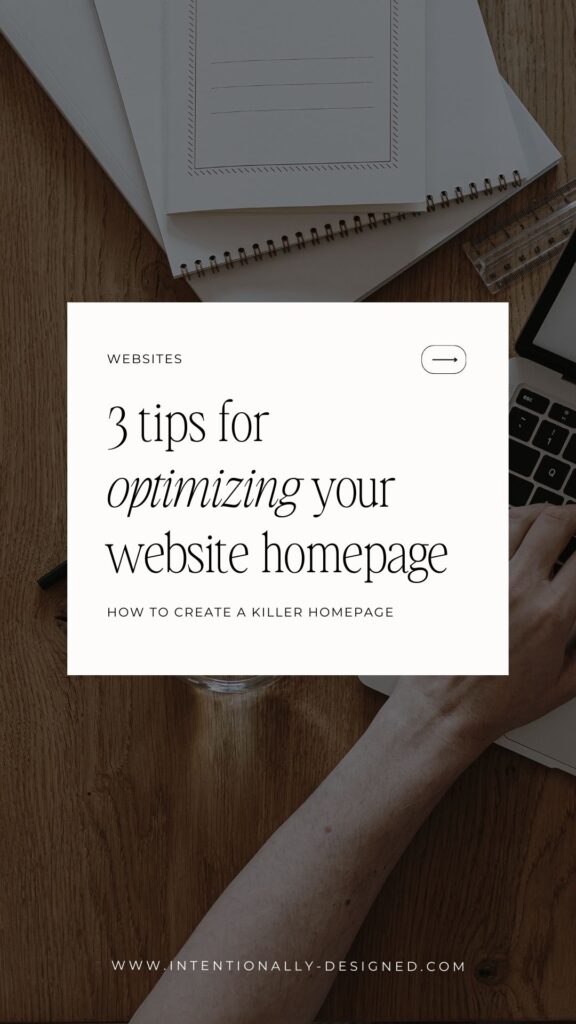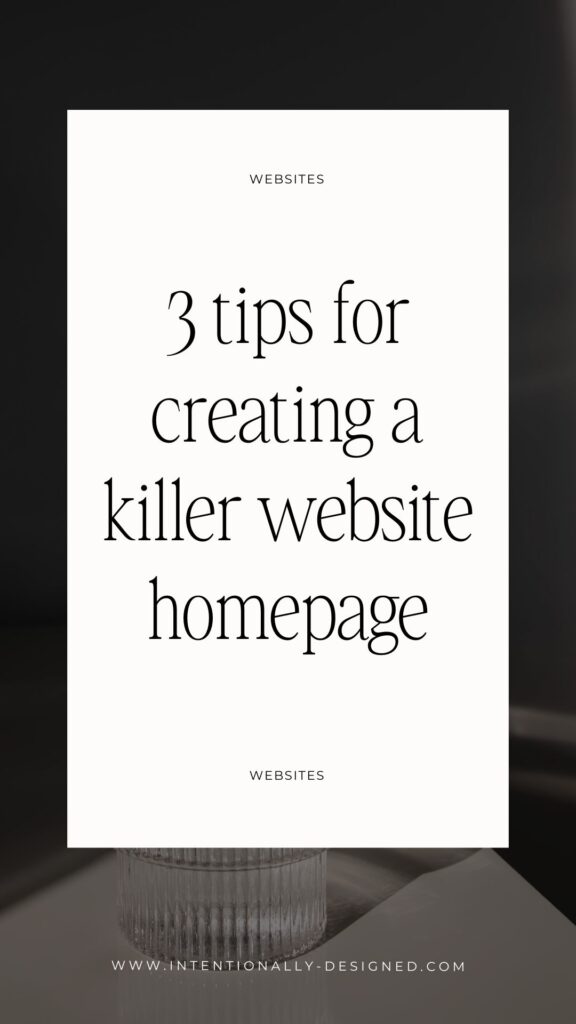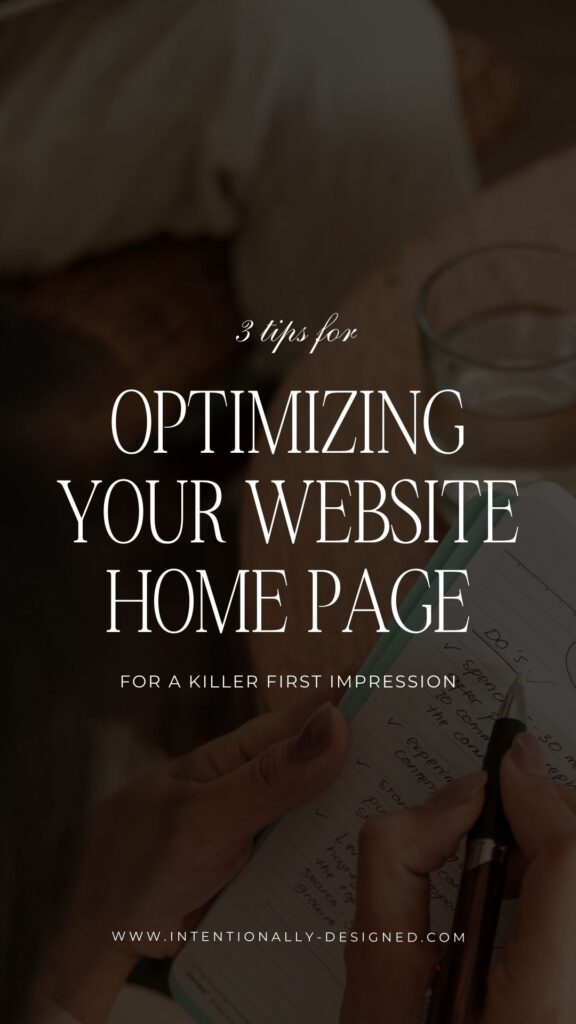Your website home page serves as the foundation of your website. It sets the tone for the rest of your website and is often the first page someone will land on when they come to your site. It’s your chance to make a good first impression and draw the visitor in for more so you want to make sure to optimize your website home page for a good first impression.
But with all that pressure from one page, your home page can be one of the hardest pages to put together on your site. You probably feel like you need to include all the things on the home page and give them all the info, without overwhelming them – which is no easy task. To make it a little bit easier for you, I’m breaking down the key components of a killer home page so you can optimize your website home page.
Why your home page is so important
It’s so important to have an online presence that is designed to connect with your ideal client, to showcase your offerings, and to seamlessly guide visitors toward purchasing your products and/or booking your services. I mean, that sounds like the dream website, right?!
With that kind of website as the end goal, we have to start with the website home page. The home page is where it all begins.
Usually, when someone lands on your site, they are probably getting to the home page first unless you are directing them specifically to a certain place on your site. But according to KoMarketing, 36% of visitors will click on the company’s logo to reach the homepage once they are on the site, so they will most likely end up there eventually.
The website home page can feel daunting because it’s that first impression that could either keep them wanting more or make them click away. You have 6 seconds to catch their attention before they want to click away, so this is where it all counts, but don’t put too much pressure on the page either.
In most cases, the home page ends up being the catch-all of content because you’re afraid your visitor will miss something important. But if it is a hodgepodge of info, nothing will make sense and they will most likely click away confused and overwhelmed in search of something simple and clear.
According to KoMarketing, 86% of visitors want to see information about your products/services on your homepage. On top of that, 52% of visitors want to see info about you too.
The bottom line is that your homepage should sum up you and your business, highlighting the high points and pointing them to where they need to go next. While all websites might be a little different based on the specific business, the goal of any home page is to let the visitor know you have the perfect solution to their problem, and then tell them what to do next.
How to optimize your website home page for maximum results
Your home page is essentially designed for someone who needs to get to know you. If someone is familiar with you they probably have been to your site before and will skip over the home page for what they are looking for specifically.
But if someone lands on your site that has no idea what you do or who you are, they will most likely visit your home page – so this is why you want to create such a killer experience for your visitor.
The test of a good home page is asking yourself – if someone visits just your home page can they get a clear understanding of what you can do for them?
Here are 3 things that will help you optimize your website home page:
- Start with a strategy – One thing to remember before diving into building your home page is the strategy behind it. If you’ve taken the time to build your site right, you should have a clear website strategy that guides the build-out of your pages. You want to be sure you have a clear purpose and objective for every page of your site, and that will come in handy when determining how to layout your home page for maximum optimization.
- Know your visitors and ideal client – This goes hand in hand with your brand and website strategy, but you want to be sure that you know who you are talking to when designing and writing for your home page. When you know who you are trying to reach it’s much easier to build a page for them.
- Keep things simple and focused – Remember your end goal and keep things focused on that. Your home page can’t be the catch-all for everything you do. You need to keep it simple and organized so they get a bird’s-eye view of your brand and clearly know what they need to do next. If they are scrolling for days with section after section covering all the details and facets of your business they will get overloaded and lost. That’s what the other pages of your site are for anyway!
A basic framework for to optimize your website home page
Although I wish there was a magic formula, there isn’t a one-size-fits-all framework for your home page. There are several sections you can (and should) include on the page but it can differ depending on your business.
The key is to make it work for your business and your ideal client.

Here is a basic framework you can follow for your home page while still tailoring it for your business:
- Clear value proposition above the fold – Tell them who are you and what you do. The first part of your website should instantly tell people what do you offer, how will it make their life better, and what they need to do to purchase. This reassures them that they are in the right place and tells them why they need to stick around. You also want to include a clear call to action here that points to your main website goal.
- Hit the pain points and touch on the problem you solve – This is where you will tell them who you serve and how can they benefit from your offering. First express empathy for how they feel and then tell them what gives you the expertise to solve their problem. This section reiterates the statement above and positions you as their guide.
- Tell them more about what you do – Here is where you can break down your offerings so they get a better understanding of how they can work with you or purchase from you.
- Tell them who you are and what makes you different – This is where you will give them more details about who you are, who you serve, and what makes you different in a short paragraph. It’s their chance to see your face and get to know you a little better so they know who is behind the brand. It gives your brand a more personal connection. Remember to keep the copy about them though – even though this is more about you and your brand, you want to keep the focus on them and frame it so that they feel seen, heard, and understood.
- Tell them what to do next – This is where you want to keep your main website goal in mind and direct them to the next place to convert that visitor. You can include a couple of CTAs on your home page, but don’t throw too many options at them either. Keep it simple and clear so they know exactly what they need to do next to book with you or purchase from you.
- Capture their email – If you’ve got an email list, your home page is a great place to encourage them to sign up. You can offer a freebie in exchange for their email to continue connecting with them and allow them to get their feet wet with you.
Some other sections you can include on your home page are:
- Blog posts or podcast episodes – you can feed the latest or most popular blog posts or podcast episodes if you want them to find your content easily.
- Featured shop items – if you are more of a product-based business, you could feature some products on the home page so they can start diving into the shop.
- Press – if you’ve got some good cred this is a great place to show it off with press logos of your best features.
- Testimonials – social proof is good to show on any page of your site as it builds credibility and authority through honest reviews from others who have worked with you.
Recap
When it comes to optimizing your website home page, less is usually more. Although this is one of the most important pages of your website, don’t put too much pressure on it to do all the things. It’s important to keep things simple and strategic so that you are giving them just the info they need to know that they are in the right place and know exactly what to do next.
Next Steps
It’s time to assess your home page. Give it the fresh eyes test and approach it as if you don’t know anything about your business. Does it tell you what you do, who it’s for, and how it will benefit you? Do you clearly know what to do next? Bonus points if you use this as market research and have someone else test out your home page for you.
More Resources
- 3 Things that need to happen before you build your website
- How to DIY your website the right way
- 4 pages you should have on your website you probably didn’t know about
- The Brand Strategy Blueprint course
- The Website Planner and Content Workbook
Save for later
Enjoy this article and find it helpful? Pin this image on Pinterest so you’ll always have this info on hand!









